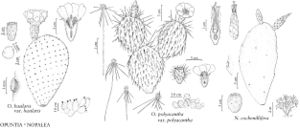Nopalea cochenillifera
Cact. Hort. Dyck. 1849, 64. 1850.
Shrubs or trees to 4–5 m; trunks 15–20 cm diam. Stem segments linear to narrowly obovate, sometimes slightly falcate, (10–) 15–35 (–50) × 5–15 cm; areoles 2–3+ cm apart, 2–5 mm diam.; wool tawny, whitening with age. Spines usually absent or 1 (–3), particularly on older pads, straight or curved, brown, aging gray, stout, to 2 cm. Glochids inconspicuous. Flowers 4–7 cm; inner tepals spatulate; crowded pink filaments and white style much longer than tepals, to 15 mm; nectar chamber elliptic to obconic. Fruits ellipsoid, 25–40 × 20–25 mm; areoles well distributed. Seeds tan to gray, 3–5 × 1.5–3 mm, slightly pubescent. 2n = 22 (Mexico, Puerto Rico as an escape).
Phenology: Flowering winter (Sep–Mar).
Habitat: Hammocks, fields, sandy soils
Elevation: 0 m
Distribution

Introduced; Fla., Mexico, West Indies (Cuba), West Indies (Puerto Rico), Central America (Panama)
Discussion
The stem segments, or pads, of Nopalea cochenillifera are used as food, fodder, and poultices, and for rearing cochineal insects to obtain a red dye (once a major industry). This species may have been selected for spinelessness in Mexico, much like Opuntia ficus-indica, to ease the culturing and collection of cochineal scale insects for red dye.
Selected References
None.
